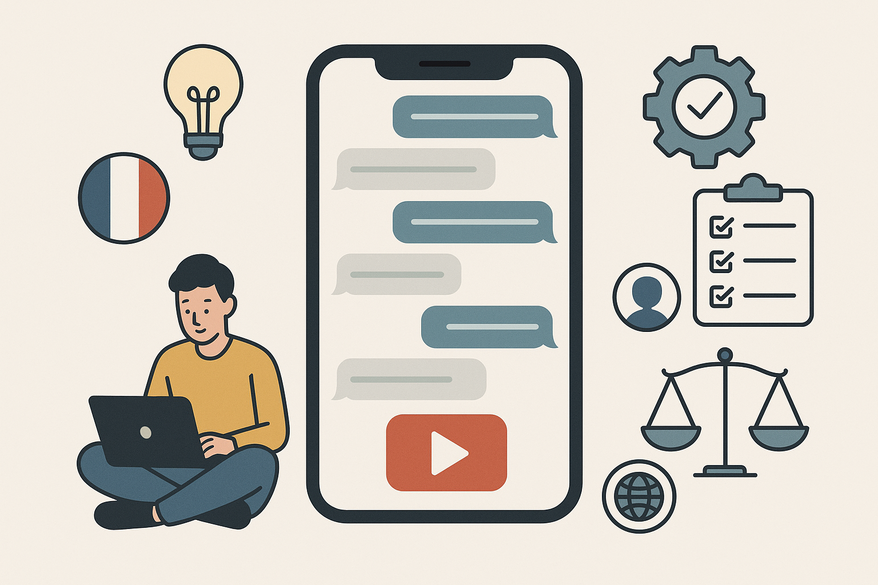How to Create a Fake Chat Video in French: Definition, Purpose, Tools & Ethics
Learn how to create a fake chat video in French, explore its purpose, tools needed, ethical considerations, and impact on digital communication.

Estimated reading time: 8 minutes
Key Takeaways
- Understand what a fake chat video in French is and its defining features
- Explore primary purposes: entertainment, storytelling, satire
- Learn step-by-step creation: scripting, tools, interface design, audio, editing
- Recognize ethical risks and best practices for transparent, responsible content
- Discover the impact on digital communication and strategies for media literacy
Table of Contents
- Section 1: What Is a Fake Chat Video in French?
- Section 2: Purpose and Uses of Fake Chat Video in French
- Section 3: How Are Fake Chat Videos Made?
- Section 4: Ethical Considerations & Authenticity
- Section 5: Impact on Digital Communication & Media
- Section 6: Tips & Best Practices for Creators
- Conclusion & Further Resources
- FAQ
Section 1: What Is a Fake Chat Video in French?
A fake chat video in French is a short video presenting a simulated conversation in a chat-style interface. All dialogue and cultural references appear in French to engage Francophone audiences.
Key characteristics of a fake chat video in French:
- Chat interface styled after WhatsApp, Messenger, SMS, or iMessage
- French text in conversation bubbles, including slang and idioms
- Inclusion of timestamps, read receipts, and typing indicators
- Optional AI-generated voiceovers or synced avatars for realism (“deepfakes”)
Common traits:
- Chat bubbles colored to match popular French app themes
- Use of colloquial French expressions (e.g., “Ça roule ?”, “Pas de souci !”)
- Quick cuts or transitions between messages for pacing
In French-speaking communities, creators use these videos for satire, dramatic effect, or viral challenges, blending artifice and humor (source: Fake news).
Section 2: Purpose and Uses of Fake Chat Video in French
Creators develop fake chat videos in French for diverse objectives. Below are the main purposes:
- Entertainment & Humor
• Parody everyday conversations or trending topics
• Example: spoof chat between two Parisians debating café culture, using exaggerated French stereotypes for laughs - Storytelling & Fiction
• Convey micro-stories via message exchanges
• Example: a suspenseful cliffhanger where a final message reads “Tu ne devineras jamais…” - Social Commentary & Satire
• Lampoon politicians, social issues, or corporate brands
• Example: a faux chat between public figures discussing climate policy in a tongue-in-cheek way
These uses showcase digital creativity and reinforce media literacy, teaching viewers to recognize constructed narratives (source: Fake news).
Section 3: How Are Fake Chat Videos Made?
Here is a step-by-step process for crafting a fake chat video in French:
Step 1: Scriptwriting
- Draft clear French dialogue with defined characters, tone, and setting. Tip: include regional slang or cultural idioms (e.g., “chérie,” “boulot”) for authenticity.
- For automated script ideas, consider an AI chat script generator to streamline your workflow.
Step 2: Choosing Tools & Platforms
- Video editors: Adobe Premiere Pro, Final Cut Pro X for advanced timelines. See chat-video editing tips.
- Chat simulators: Fake Chat Maker, WhatsMock, or web-based “Fake WhatsApp Chat” tools. For iMessage-specific generators, check iMessage chat video generator guide.
- AI/Deepfake options: GAN-based tools like DeepFaceLab for avatar sync or custom text-to-speech engines.
Alternatively, you can streamline your French chat video production using Vidulk - Fake Text Message Story App.
Step 3: Designing the Interface
- Match UI elements: bubble colors, fonts (e.g., San Francisco for iOS, Roboto for Android), timestamps.
- Export static chat screenshots or record screen captures.
- Layer chat assets on the video timeline, adjusting sizes and positions to mimic phone displays.
Step 4: Adding Voice & Sound (optional)
- Use AI-powered voice tools (Google Cloud Text-to-Speech or Amazon Polly) to produce native French voices. For voice tips.
- Sync waveform displays beneath bubbles to show real-time speech.
- Incorporate ambient sounds (notification pings, typing clicks) for immersion.
Step 5: Final Editing & Export
- Apply transitions (crossfades, zooms) and simple background music to set mood.
- Add on-screen disclaimers in French: “Vidéo fictive / Contenu satirique.”
- Export formats: vertical (9:16) for TikTok/Reels, square (1:1) for Instagram feed, 16:9 for YouTube.
Advanced productions may incorporate AI-generated voices or visuals to heighten realism (source: Fake news).
Section 4: Ethical Considerations & Authenticity
Ethical creation of fake chat videos in French requires clear distinctions between fiction and reality.
Ethical risks:
- Misleading viewers into believing chats are genuine
- Potential defamation or privacy violations if impersonating real people
Platform guidelines:
- X/Twitter authenticity policy: include “parody,” “fake,” or “satire” in captions or hashtags (source: X authenticity policy).
- YouTube community guidelines: label content in titles or descriptions to avoid misleading audiences.
Best practices:
- On-screen disclaimer: “Vidéo fictive / Contenu satirique.”
- Description box note: “Ce contenu est fictif. Toute ressemblance est fortuite.”
- Avoid mimicking real individuals without explicit consent or a clear parody label.
- Use watermarks reading “Faux Chat” to reinforce that the conversation is staged.
- For legal risks and case studies, see legal fake text message videos.
Section 5: Impact on Digital Communication & Media
Fake chat videos in French have reshaped digital storytelling and participatory culture.
Role in modern storytelling:
- Integrates text-based narrative with visual design, bridging comics and video mediums.
- Offers quick, digestible story bites ideal for mobile viewers.
Boost to media literacy:
- Encourages audiences to question authenticity and recognize digital manipulation.
- Serves as an educational tool in classrooms for critical thinking about online content.
Trends to watch:
- Emergence of “deepfake chat” videos on TikTok Reels and YouTube Shorts.
- Viral challenges where users guess which chat is real versus fabricated.
- Collaborations between influencers to stage multilingual chat dramas.
Section 6: Tips & Best Practices for Creators
- Write clear, concise French dialogue with correct grammar and regional accuracy.
- Match UI design to popular messaging apps, then overlay a “Faux Chat” watermark.
- Add disclaimers: both on-video text (“Vidéo fictive”) and in captions/descriptions.
- Test readability on various mobile screen sizes; ensure text font and color contrast.
- Keep videos under 60 seconds for higher retention on TikTok and Instagram Reels.
- Monitor comments and respond quickly to clarify any confusion or misconceptions.
Reminders:
- Prioritize creative storytelling over deception.
- Use humor, drama, or social critique to engage responsibly.
- Label your work clearly to comply with platform policies (source: X authenticity policy).
Conclusion & Further Resources
Creating a fake chat video in French offers a powerful medium for humor, narrative, and social critique, provided ethical labeling and transparency are maintained. You’ve learned what this format is, why it’s popular, how to craft it, and best practices to avoid misinformation.
Further resources for deeper learning:
- Fake chat generator directories (search “fake chat generator” online)
- Video editing tutorials on YouTube (“How to simulate a chat interface”)
- Media literacy guides on recognizing fabricated content (source: Fake news)
- Platform authenticity policies (source: X authenticity policy)
FAQ
- Is it legal to create a fake chat video?
Generally, yes—provided you clearly label it as fiction, avoid defamation, and respect privacy rights. Always check local laws and platform policies. - How can I make my French text sound authentic?
Use regional slang, idioms, and consult native speakers or online dictionaries. Research cultural references to avoid awkward phrasing. - What tools are best for simulating chat interfaces?
Fake Chat Maker, WhatsMock, web-based Fake WhatsApp Chat generators, and Vidulk offer quick mockups. Advanced users may prefer Adobe Premiere Pro or Final Cut Pro with custom graphics. - How do I ensure ethical compliance?
Add clear on-screen disclaimers, use “parody” or “satire” tags, and avoid impersonating real individuals without consent. Review platform authenticity policies before publishing.





